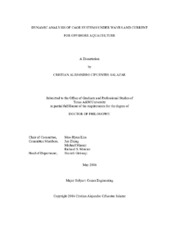| dc.description.abstract | The accurate computation of forces and corresponding deformation of cages subjected to waves and current loading is critical to the design of mooring systems for fish farms. In the present work, a complete methodology describing the numerical modeling of net structures and its corresponding interaction with mooring lines and floating platforms has been developed. The effect of every element on the cage over the global response and the effective numerical representation of these components of a cage system are studied.
The numerical model of cages is built and calculated using the commercial software OrcaFlex v9.6a. In this software, an equivalent net model is created using an array of cylinders connected by buoys. This model has the same wet mass, axial stiffness and projected area as the prototype net, allowing for the accurate calculation of forces and deformations over the cage due to wave and current loading. A variable drag coefficient formulation is implemented in the software, based on the relative normal velocity between line elements and fluid. This drag coefficient is fed into the modified version of the Morison equation, which accounts for relative motion, to obtain the drag force on the netting using the cross flow principle. In addition, shielding effect is included in the calculations by using riser interaction models. Furthermore, blockage due to large deformations of flexible cages is also accounted for by the derivation of a semi empirical formulation for drag coefficient on Raschel nets.
Careful validation of the present methodology is conducted by comparing numerical results with experimental published data. Validation is presented for a single cage, which includes a surface flexible collar, netting, ballast and mooring lines. Applied loads include current, regular waves and a combination of regular waves and current to evaluate interaction effects. The influence of wave kinematics stretching models on mooring line tension results is also analyzed. Additionally, calculations considering irregular waves and following current are performed for the completeness of the study.
Further analyses consider the coupled response of a mooring/platform/cage system. The system intends to describe the interaction of a single cage and a feeder vessel installed in deep water. Effects of the location of the cage in the water column and the net selection on the dynamics of the platform are studied. The results are qualitatively compared against field measurements in a similar installation 6 miles offshore of Kona Hawaii.
This study can directly be applied to the calculation of the coupled response of multiple technologies such as floating offshore wind turbines, wave energy conversion and offshore fish farming. | en |


